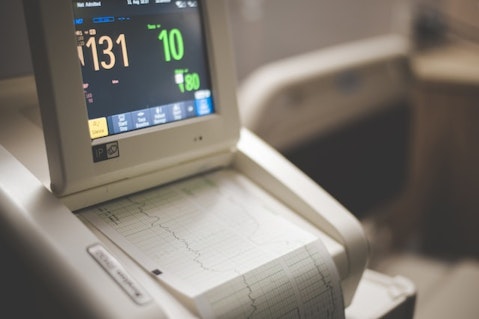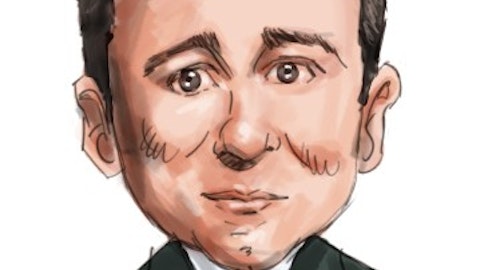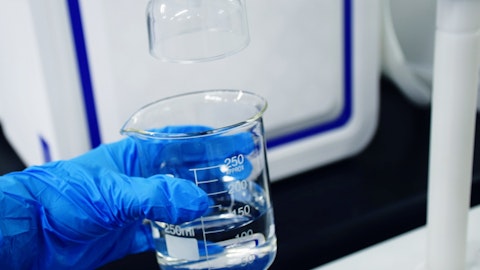Trinity Biotech plc (NASDAQ:TRIB) Q4 2022 Earnings Call Transcript March 23, 2023
Operator: Good morning and welcome to the Trinity Biotech Fourth Quarter 2022 Financial Results Conference Call. All participants will be in listen-only mode. After today’s presentation, there will be an opportunity to ask questions. Please note this event is being recorded. I would now like to turn the conference over to Joe Diaz with Lytham Partners. Please go ahead.
Joe Diaz: Thank you, and thanks to all of you for joining us today to review the financial results of Trinity Biotech for the fourth quarter and full-year 2022, which ended on December 31, 2022. Joining us on today’s call are Aris Kekedjian, Chief Executive Officer; and John Gillard, Chief Financial Officer. At the conclusion of today’s prepared remarks, we will open the call for a question-and-answer session. Before we begin, statements made in this conference call may be deemed forward-looking statements within the meaning of federal securities laws. These statements are subject to known and unknown risks and uncertainties that may cause actual results to differ from those expressed or implied in such statements. These risks include, but are not limited to, those set forth in the risk factor statements in the company’s annual report on Form 20-F filed with the Securities and Exchange Commission.
Trinity Biotech undertakes no obligation to publicly update or revise these forward-looking statements to reflect events or circumstances after today or the occurrence of unanticipated events. With that, I will now turn the call over to CEO, Aris Kekedjian for opening remarks. He will be followed by CFO John Gillard for a review of the financial results. Mr. Kekedjian will then provide some additional background, after which we will open the call for your questions. Aris, the floor is yours.
Aris Kekedjian: Thank you, Joe. Good morning, everyone. I like to start the call discussing key revenue, commercial, and operating highlights. I will also give context to various strategic activities we have underway. John will follow with a deeper dive into our reported financials and then we’ll be happy to take your questions. First, let me discuss the revenue trends. Total revenue for fiscal 2022 and Q4 2022 were 74.8 million and 18 million, respectively. Excluding our COVID focused PCR Viral Transport Media products, full-year 2022 revenues of $71.5 million were 1% lower than in 2021 and in Q4 2022 revenues were less than 0.5% lower than in Q4 of 2021. Our performance in 2022 was focused on our core flagship hemoglobins business, where our diabetes product line experienced 27% overall revenue growth and over 60% higher instrument placements versus 2021.
As highlighted by the 43% growth in sales of high-margin diabetes consumables in Q4 2022 versus Q4 2021, the increased instrument placements position the company for strong recurring revenues in contracted consumables sales over the next several years. We expect to expand on the strategy with the U.S. launch of our Premier Resolution Hemoglobin Variants instrument this year as we continue to work closely with the FDA to gain clearance of our 510(k) submission. The company also continued to development its next generation flagship diabetes HbA1c instrument, the Premier 9210. With an expected launch in Q3, 2023, the instrument will feature an improved, backward compatible reagent column system that will feature up to 3x the injection capacity and stability, limited calibration, and improved user interface and lab system integration.
This is the first step of a multi-generational product development plan aimed at expanding the target market, driving lower service downtime and cost, while significantly expanding operating margins. We are experiencing particularly strong demand for our diabetes products in South America and Asia Pacific, with 43% year-over-year revenue growth in South America and 36% year-over-year revenue growth in Asia-Pac. We continue to scale our commercial coverage in these markets where the increase in diabetes and propensity for hemoglobin variants is at some of its highest rates and our boronate affinity technology has a particular competitive advantage. While our HIV business was down 14% in the year, this reflected significant non-recurring bulk orders from Nigeria in 2021.
Our run-rate core Uni-Gold business continues to perform steadily with 15% growth in the fourth quarter versus last year and 10% growth versus Q3, 2022. Preliminary estimates for Q1 indicate that over 30% improvement versus Q1 2022 will be expected. I would now like to discuss an important milestone for the company that was achieved this week. The company is very much focused on executing beginning in Q2 2023 on the launch and distribution of our TrinScreen HIV test. Following the announcement by the Kenyan Ministry of Health of the adoption of this new HIV rapid testing algorithm it establishes Trinity Biotech’s TrinScreen HIV as a standard screening test in Kenya under World Health Organization guidelines. The Kenyan HIV screening program is one of the largest in Africa, with an estimated 7 million to 9 million screening tests annually.
This announcement demonstrates Trinity’s ability to disrupt a well-established incumbents with world-class, innovative, high-quality point of care solutions. We aimed at the Kenyan algorithm as a priority as we believe it sets a key benchmark for the region. We are leveraging this milestone with significant focus in 2023 on two to three additional countries, which represent a combined expected annual test volume of over 25 million. We expect to achieve at least 20% market share of the 150 million African HIV screening market over the next three years. Now, moving on to a string of activities aimed at transforming our U.S. lab platform. With a 13% CAGR over the last three years, the company continues to see significant growth in its proprietary Sjogren’s bio-marker lab developed tests.
This has been achieved despite limited to almost no commercialization activities. Plans are in development for distribution through ophthalmology, dental, and gynecological channels at scale. We’ll talk to you more about this in the coming months. In January 2023, the company announced a strategic partnership with imaware, Inc. that combines imaware’s built-to-partner digital health platform with Trinity’s advanced reference laboratory facilities. The aim is to power the Digital Health Industry with private and white-label at-home and remote testing programs. We are working closely together to make this operational execution a reality in 2023. Finally, the company intends to introduce up to a dozen new lab developed tests in 2023 targeted at the Therapeutic Drug Monitoring or TDM market.
This is aimed at high-growth recurring revenue opportunities in autoimmune diseases such as IBD, Rheumatoid Arthritis, and Psoriatic Arthritis, as well as rapidly expanding biological therapeutics tackling areas such as cancer and degenerative diseases such as Alzheimer’s. Stay tuned for more discussion about this in the coming weeks. I would now like to give you context around significant portfolio formation and M&A activity that we are working on. Obviously, we can’t discuss activities that are subject to confidentiality agreements are commercially sensitive or not yet far enough along to be announced. However, I can be quite direct about the company’s portfolio focus going forward. We are conducting a portfolio review of all activities that do not align with a strategic focus around three key priorities.
Specifically diabetes and hemoglobins; point of care and digital health disruption; and personalized therapeutic drug monitoring. The intention over the coming months is to simplify the portfolio around these three areas where the TAMs are enormous, the risk return profiles are asymmetrically in our favor where we have competitive advantage and where our shareholders are clear on Trinity Biotech’s investment thesis. Management intends to exit or optimize for cash its portfolio of non-core products and platforms in order to maximize shareholder value and leadership’s focus on where that value lies. Given the strong pipeline of attractive M&A opportunities in our areas of strategic focus, in February we secured a $20 million flexible term-facility specifically to provide the ability to move quickly when opportunistic transactions arise.
This is a very opportune time to gain significant innovative product pipeline at fractions of where they were valued only a few months ago. Our portfolio optimization efforts and opportunistic M&A are key to our efforts to optimize our capital structure and reduce our debt costs in 2023. Now, I’d like to take a moment to discuss some structural and operational initiatives we have underway. Cost optimization and pricing actions have resulted in a Q4 operating gross margin run rate of over 40%, excluding one-time inventory adjustments. This reflects over 5 points of improvement over the same quarter in 2021 and over Q3 2022. The company has reduced headcount by approximately 10% to Q4 2021 as we continue to focus on process simplification and automation.

Photo by Stephen Andrews on Unsplash
Our increased IT spend in the fourth quarter also reflects significant investments underway in CRM, ERP, and regulatory automation to drive speed and further efficiencies. Our emphasis on supply chain optimization is currently in our hemoglobins division focused at reducing the cost of the premier 9210 diabetes from by approximately 15% in conjunction with our multi-generation product development plan. Significant margin accretive actions for Q2 2023 are the insourcing of key hemoglobin’s manufacturing processes and rapid transformation of our global logistics operations. One of my priorities over the last quarter has been restructuring and revitalization of our commercial sales organization on a global basis. We eliminated an effective leadership overhead, rebuilt commission plans, and continue to refresh our global distribution channels.
I am personally managing this effort. Finally, I’d like to take a moment to emphasize our focus on the most important element of our transformation strategy, Talent. A highly motivated, shareholder aligned leadership team is at the core of the company’s strategy. We are in the process of rolling out a revised employee share-based compensation program aimed at driving significant shareholder value. The plan follows the same structure as the CEO of share-based compensation plan whereby 60% of options are stock performance based and only pay-out when the stock reaches trading milestones at $3, $4, and $5 per ADS. This structure is designed to be fully aligned with shareholder interest to create exponential shareholder value. As you can tell from the structure of our performance options, moderate stock price improvements to $2 or $3 ADS is not where our interest lies.
I think it’s important to point out that we are on a multi-year transformation of Trinity Biotech. Our performance option is best over a three-year period and as of the timeframe the entire management is committed to. When I took this role, I underwrote the minimum value for which three years was worth my time. That value is $10 higher than what we are now. At 5 million options, you can do the math. I’ll now turn things over to John and come back to answer any questions. Thank you.
John Gillard: Thank you, Aris. Good morning, everyone. Now, I will take you through the results for Q4 2022. As Aris has already discussed revenue trends, I will move on to disclose other aspects of the income statement. In Q4 2022, gross profit was $6.2 million, gross margin of 34.6%. In Q4 2021, gross profit amounted to $7.2 million and the gross margin of 37.1%. The reduction in gross margin is largely due to sales mix changes, lower production activity, and inflationary increases in the price of raw materials. We have started to see the benefit of price increases and cost optimizations implemented in mid-to-late 2022 now starting to be realized, as seen by the fact of the Q4 2022 margin of 34.6% is higher than the adjusted Q3 2022 margin of 34.4% when excluding the significant excess and obsolescence charges related to inventory of $4.7 million reported in Q3.
As Iris mentioned in Q4 2022, we saw run rate gross margins, excluding quarter and year-end inventory adjustments of approximately 40%. Other operating income decreased from $0.7 million in Q4 2021 to $0.3 million in Q4 2022. This quarter, other operating income comprises of government grants in relation to R&D activities. In Q4 2021, we recorded $0.7 million of other operating income related to the Paycheck Protection Program loan which was forgiven in that quarter. R&D expenses increased from $0.9 million in Q4 2021 to $1.2 million when compared to Q4 2022. This is because various early-stage development activities did not meet the criteria under IFRS for capitalization as an intangible asset. SG&A expenses have increased significantly this quarter.
In Q4 2021, SG&A expenses were 5.6 million and this has increased to $10.2 million this quarter. There are a few significant contributions to this increase. Firstly, our share option increase expense has increased by 1.2 million, compared to Q4 2021. This charge is a notional accounting charge calculated under a Black-Scholes financial model. As previously set out by Aris, one of his key priorities is to build a performance culture and drive ownership and accountability in the company. A share-based compensation model that ensures shareholder alignment is regarded as core to this transformation and we are currently ruling this out. As this point in time, it is intended that these share-based compensation awards will be structured in a manner similar to that of the options granted to our CEO, with a significant proportion of any awards being performance-based awards that only become exercisable if the company’s ADS price reaches a hurdle level.
These performance share-based compensation awards are intended to closely align the goals of our team with those of our shareholders in the creation of shareholder value. The majority of the options granted in Q4, 2022 are performance share options and are structured such that they are exercisable only if the company’s ADS price increases to certain levels such as $3, $4, and $5 per ADS during the life of the option. None of these performance share options are currently exercisable. Also this quarter, there was an unfavorable quarter-on-quarter variance of $900,000 related to foreign exchange loss and euro denominated lease liabilities right of use assets. We are required under accounting rules to these lease liabilities at the period end FX rates.
In Q4 2021, this resulted in a foreign exchange gain on leases of $0.2 million, but in Q4 2022 it was a foreign exchange loss of $0.7 million. We have also incurred higher legal and professional fees of approximately $1 million, mainly comprising non-recurring costs for due diligence, corporate development, and corporate finance activities. Included in this cost are professional fees in relation to several M&A opportunities, of which only the strategic partnership with imaware has been completed to date. Excluding the accounting charges around share based compensation, I do not believe that these types of charges have become inherent in our cost base and thus I don’t expect them to continue into the medium-term future. In addition, in SG&A expenses we have seen increase in travel costs in Q4 2022, compared to Q4 2021 of approximately $300,000.
With the lifting of COVID-related travel restrictions, we have tasked our sales and marketing teams to increase travel to customers and trade shows as we continue to revitalize our sales activities. Similarly, some key functional leaders based in Ireland have resumed visits to our overseas facilities as we seek to drive operational efficiencies. Management believes this is a worthwhile and important investment, but we do not expect the level of travel to stay at this level going forward. We have recognized an impairment charge of $3 million in Q4 2022, compared to an impairment charge of $900,000 in Q4 2021. At December 31, 2022, two internally developed COVID-19 tests, one on a rapid lateral flow format and one an ELISA format, which had carrying values of $2.2 million and $0.1 million, respectively, within intangible assets, were reviewed for impairment under IFRS.
The rapid COVID-19 test is approved for professional use in the EU and we believe it is a very high quality test. However, as previously disclosed by the company, the demand for our COVID-19 portfolio of products is highly uncertain and very difficult to predict and in our experience the market has moved to over the counter rapid COVID-19 tests, for which this product is not yet approved. As such the company’s efforts to commercialize this test have been unsuccessful. In addition, pricing for rapid COVID-19 tests in the EU is relatively weak, with stronger pricing available in, for example, the U.S. market, for which this product is not yet approved. Given the market outlook for rapid COVID-19 testing products and continued uncertainty regarding regulatory approval pathways in key markets, including the U.S., management has chosen to not immediately pursue further regulatory approvals, but does intend to monitor these markets and regulatory pathways with a view to potentially seeking additional regulatory approvals.
However, as the company has no imminent plans to pursue these regulatory approvals, under IFRS accounting rules these intangible assets were written down to zero in Q4, 2022. The impairment test at December 31, 2022 also identified an impairment loss of Clark Laboratories and Trinity Biotech Do Brazil. There were a number of factors taken into account in the impairment test, including the company’s share price at the date of the test, the cost of capital, and future projected cash flows from individual cash-generating units in the business. Operating loss for the quarter was $7.8 million, which represents a decrease in profitability of $8.4 million, compared to Q4 2021 and was attributable to a lower gross profit, lower other operating income, and higher indirect costs.
Financial income for Q4 2022 was $0.1 million, compared to $10,000 for Q4 2021. In Q4 2022, financial income mainly related to the fair value adjustment for the derivative liability related to warrants granted to the Group’s principal lender. Financial expenses in Q4 2022 were $2.4 million, compared to $3 million in Q4 2021, a decrease of $600,000. The interest expense related to the senior secured term loan and the 7-year convertible note were $1.9 million and $0.3 million, respectively in Q4 2022. These amounts consist of both cash interest and non-cash accretion interest. As both of these borrowings were new in 2022, there was no interest expense recorded in the comparative period’s results in respect of these facilities. In Q4 2021 the cash and non-cash interest expense for the exchangeable notes was $1.2 million, which was reduced to almost zero in Q4 2022, due to the debt re-financing earlier in the year.
In Q4 2021, loan origination costs of $1.6 million were incurred, comprising loan commitment and professional fees. These costs were expensed in the income statement in Q4 2021, as the loan was subject to shareholder approval and that approval was not received until post the balance sheet date. The remainder of the financial expense in Q4 2022 and Q4 2021 consists of notional interest on lease liabilities for right-of-use assets, which has remained broadly stable at $160,000. I propose to just talk briefly about our full-year numbers for the fiscal year 2022. Starting with revenues, as mentioned by Aris, total revenues for 2022 were $74.8 million, compared to $93 million in 2021. Gross margin for the year was 29.5%, compared to 41% for 2021.
The reduction in margin was mainly due to three factors: one, a $4.7 million inventory write-down; two, a large reduction of VTM product sales. These products had a higher than average margin in 2021; and three, rising input prices exceeding the price increases we passed on to our customers. Indirect costs have increased by 3 million year-on-year. The major movements here and lastly, our professional fees mainly associated with our M&A and corporate development activities. Financial expenses were higher by 17.6 million, three quarters of this increase comprised two non-recurring expenses. One, the last disposal of the exchangeable notes; and two, the penalty for early settlement of part of our term-loan. I will now move on to address some of the main balance sheet movements we have seen since quarter three, 2022.
Intangible assets decreased by $1.9 million. This is made up of additions of , which mainly comprises capitalized R&D expenditure, partially offset by amortization of $200,000, and the impairment charges for the two development projects of 2.3 million. As noted last quarter, the amount the company is spending on capital R&D expenditure has been trending downwards. And this is because several of the main projects we’ve been working on have reached the final phase of their development and then the final phase, fewer resources are typically required. In addition, some of our more recent R&D projects are at a feasibility very early stage and thus don’t meet the requirements for capitalization under IFRS. Inventories decreased by 1.1 million, equating to approximately a 4% reduction.
This is an area we are targeting and we have an ongoing project aimed at optimizing our inventory levels going forward. As part of our focus on improving the overall effectiveness and efficiency under . Accounts receivable balances on the other hand have decreased by 1.5 million and this is mainly a function of the lower sales this quarter. Finally, I will discuss our cash flow for the quarter. Our cash balance increased by $700,000 to 6.6 million in Q4 2022. Cash generated from operations for the quarter was . Capital expenditure outflows comprising were 1.1 million, a reduction of compared to the comparative period. Interest payments in the quarter were 1.2 million. As set out in today’s press release, I can assure you that as the group CFO and a member of the senior management team, we are acutely aware of the relatively high cost of the company’s borrowing.
While the financial markets are clearly in a difficult place, I believe we have a number of potential options to successfully deal with our debt costs, while at the same time releasing capital and management time to focus on high growth areas where Trinity can become a globally significant player. As mentioned by Aris, we are actively examining the potential disposal of parts of our portfolio of businesses that are non-core to our future vision and strategy, where valuations may be attractive, while also examining a number of alternative financing options. It is an absolutely key area of focus for us. I will now hand you back to Joe. Thank you everyone.
Aris Kekedjian: I’ll take it. It’s Aris. I think we can open it up for questions.
See also 10 Best Cruise Stocks To Buy Now and 10 Best Delivery Stocks To Buy Now.
Q&A Session
Follow Trinity Biotech Plc (NASDAQ:TRIB)
Follow Trinity Biotech Plc (NASDAQ:TRIB)
Operator: Our first question is from Jim Sidoti with Sidoti & Company. Please go ahead. Mr. Sidoti, your line is open on our end. Perhaps it’s muted on yours.
Jim Sidoti: Sorry about that. Hi, good afternoon. Thanks for taking the question. I’d like to start-off with the HIV business. How quickly do you think you’ll start shipping products to Kenya?
Aris Kekedjian: I think we’ll start shipping in the second quarter. That’s the intention. And the idea we’re looking somewhere in the range of about 4 million or 4.5 million tests for the year in Kenya. Maybe more depending on production ramp up.
Jim Sidoti: Can you disclose an ASP for the test?
Aris Kekedjian: I’m sorry, what was that?
Jim Sidoti: The pricing per test.
Aris Kekedjian: John, are we okay to discuss it?
John Gillard: As we’ve previously indicated, Jim, it’s around in and around $0.80 and it’s consistent with that.
Jim Sidoti: Okay. And that’s just to Kenya. Does getting Kenya on board help you with the other two or three countries in the region?
Aris Kekedjian: That was the entire strategy from the beginning. So, Kenya is upwards of 9 million tests a year on a run rate basis. So, we think that’s our target to work toward over the next 12 months to 18 months in Kenya. We also think that the standard we just set in Kenya helps establish the momentum around the next 2 to 3 markets that I highlighted earlier and we’re talking about over 25 million tests in those markets. And I expect this to get at least 20% market share in this space over the next 2 years to 3 years.
Jim Sidoti: And what has to
John Gillard: Sorry, Jim. Just to make the point, Kenya would be regarded as a leader in terms of HIV care on the continent and we believe will be at significant influential status in terms of proving out the quality of the product. And so, I have secured that as the first country, it’s obviously a large market, but it also we think will have significant persuasive value in terms of opening up other markets to .
Jim Sidoti: And do you think the other countries will then pause for 6 months or 8 months to see how things roll-out in Kenya before they make early decisions?
Aris Kekedjian: Look, I think some may, but the reality is, they typically I mean, there’s a full report you can look at that the Kenyan authorities have put out. They did extensive studies. We did field tests. There’s a lot of work that’s been done over the last 6 or 7 months. All that information now is in the hands of all the other authorities to work off and get a head start on. So that’s how I would think about at this point. Is it possible some will wait to see how it rolls out or potentially, but like I said, we expect to start shipping in April. So, I think that’ll make that will get us going relatively quickly.
Jim Sidoti: Okay. And then on the hemoglobin business, with the hemoglobin variant and the HbA1c systems, where do you expect initial sales to happen? Is that in Asia and South America or will those be in the U.S.?
Aris Kekedjian: Which sales are you talking about? Are you talking about the hemoglobin variant product?
Jim Sidoti: Both.





